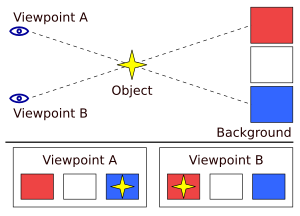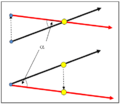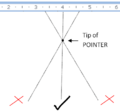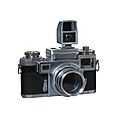Parallax facts for kids
Parallax is the apparent change in an object's position when you view it from two different places. Imagine holding your finger out in front of your face. Close one eye, then the other. Your finger seems to jump! That's parallax in action.
Scientists, especially astronomers, use this idea to figure out how far away things are. It helps them measure distances to objects like the Moon, the Sun, and even faraway stars. The closer an object is, the more it appears to shift.
Contents
Understanding Parallax
Parallax happens because your viewing position changes. If you look at something from one spot, then move to another spot and look again, the object will seem to have moved against its background. The amount it seems to move is the parallax.
This "shift" is measured as an angle. The bigger the angle, the closer the object is to you. This simple rule allows us to calculate distances.
Parallax in Astronomy
Astronomers use parallax to measure the vast distances to objects in space. This is especially important for stars outside our Solar System. It's the most direct way to find out how far away they are.
Measuring Star Distances
To measure a star's distance using parallax, astronomers take pictures of the star at different times of the year. They usually do this six months apart. Why six months? Because after six months, the Earth has moved to the opposite side of its orbit around the Sun. This creates a very long baseline for observation.
- First, they measure the star's position from one side of Earth's orbit.
- Six months later, they measure the star's position again from the other side of Earth's orbit.
- Because the Earth's orbit is well known, they know the exact distance between these two viewing points.
- They then use trigonometry (a type of math dealing with triangles) to calculate the star's distance.
This method works best for stars that are relatively close to us. For very distant stars, the parallax angle becomes too tiny to measure accurately.
The Cosmic Distance Ladder
When stars are too far away for the parallax method to work, astronomers use other techniques. These methods are often built upon the distances found using parallax. This system of different distance-measuring techniques is called the "cosmic distance ladder". Parallax forms the first, most accurate step on this ladder.
Hipparcos Satellite
From 1989 to 1993, a special satellite called Hipparcos was used to measure the parallax of over 100,000 nearby stars. This helped astronomers create a very accurate map of our local stellar neighborhood.
Parallax and Your Eyes
You experience parallax every day without even realizing it! Your two eyes are in slightly different positions on your head. This means each eye sees the world from a slightly different angle. Your brain then combines these two images. This process is called stereopsis.
This difference in what each eye sees helps your brain figure out how far away objects are. It gives you depth perception, allowing you to see the world in 3D. Without it, everything would look flat, like a picture.
Images for kids
-
A simplified illustration of the parallax of an object against a distant background due to a perspective shift. When viewed from "Viewpoint A", the object appears to be in front of the blue square. When the viewpoint is changed to "Viewpoint B", the object appears to have moved in front of the red square.
-
In this photograph, the Sun is visible above the top of the streetlight. In the reflection on the water, the Sun appears in line with the streetlight because the virtual image is formed from a different viewing position.
-
Parallax is an angle subtended by a line on a point. In the upper diagram, the Earth in its orbit sweeps the parallax angle subtended on the Sun. The lower diagram shows an equal angle swept by the Sun in a geostatic model. A similar diagram can be drawn for a star except that the angle of parallax would be minuscule.
-
Hubble Space Telescope – Spatial scanning precisely measures distances up to 10,000 light-years away (10 April 2014).
-
Contax III rangefinder camera with macro photography setting. Because the viewfinder is on top of the lens and of the close proximity of the subject, goggles are fitted in front of the rangefinder and a dedicated viewfinder installed to compensate for parallax.
See also
 In Spanish: Paralaje para niños
In Spanish: Paralaje para niños













